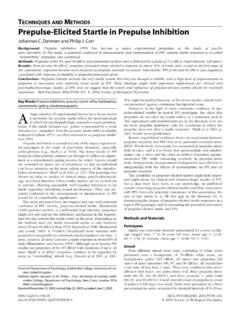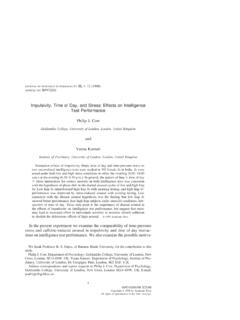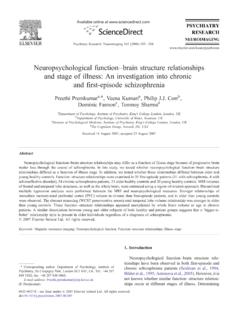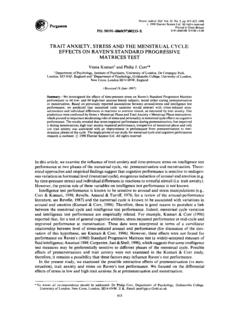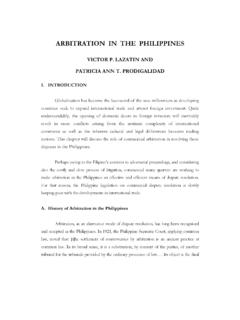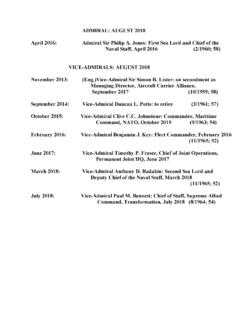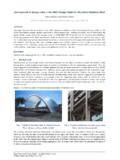Transcription of Effects of Procyclidine on Eye Movements in Schizophrenia
1 Effects of Procyclidine on Eye Movements in SchizophreniaUlrich Ettinger1,2, Veena Kumari1,3, Elizabeth Zachariah1, Adrian Galea1, Trevor J Crawford4, Philip J Corr2,David Taylor5, Mrigendra Das1and Tonmoy Sharma*,61 Division of Psychological Medicine, Institute of Psychiatry, UK;2 Department of Psychology, Goldsmiths College, University of London, UK;3 Department of Psychology, Institute of Psychiatry, UK;4 Mental Health and Neural Systems Research Unit, Psychology Department, LancasterUniversity, UK;5 Pharmacy, The Maudsley Hospital, London, UK;6 Clinical Neuroscience Research Centre, Dartford, UKSmooth pursuit eye movement (SPEM) and antisaccade deficits are observed in the Schizophrenia spectrum and have been used to studythe pathophysiology as well as the genetic basis of this condition.
2 The neurotransmitter acetylcholine has been implicated in a number ofcognitive processes thought to underlie SPEM and antisaccade performance. This study investigates Effects on eye Movements ofprocyclidine, an anticholinergic drug often administered to schizophrenic patients. A total of 13 patients completed a double-blindplacebo-controlled crossover design, receiving 15 mg Procyclidine and placebo. Seven participants received Procyclidine first and placebosecond, six participants were tested in the reverse order. SPEM and antisaccade (as well as fixation and prosaccade) eye movementswere recorded using infrared oculography. Results showed that Procyclidine overall, relative to placebo, mildly worsened SPEM performance, as indicated by nonsignificantly reduced gain (p ) and increased frequency of intrusive anticipatory saccades duringpursuit (p ).
3 A significant interaction of group and order of administration indicated that Procyclidine increased the rate ofantisaccade reflexive errors only when administered first; the opposite pattern was observed when placebo was administered first, likelydue to the operation of practice Effects at second assessment. These findings indicate that acute administration of a clinically relevantdose of Procyclidine leads to mild impairments in eye movement performance in schizophrenic patients, suggesting the need to considerthis compound in oculomotor studies in Schizophrenia . The action of this anticholinergic drug on oculomotor performance is consistentwith the hypothesized role of the cholinergic system in the cognitive mechanisms of attention and working memory, processes thoughtto underlie SPEM and antisaccade performance.
4 Effects of order of administration and practice on the antisaccade task suggest that thesefactors need to be taken into consideration in future pharmacological (2003)28,2199 2208, advance online publication, 27 August 2003; : Schizophrenia ; Procyclidine ; anticholinergic; smooth pursuit eye Movements ; antisaccade; cognition INTRODUCTIONP rocyclidine(1-cyclohexyl-1-phenyl-3-(pyr rolidin-1-yl)-propan-1-ol hydrochloride) is a synthetic anticholinergicagent (Whitemanet al, 1985). While previously used in thetreatment of Parkinson s disease (Brocks, 1999), it is nowmost commonly administered to schizophrenic patients inorder to alleviate antipsychotic-induced side Effects (Mind-hamet al, 1977; Spohn and Strauss, 1989).Central cholinergic projections are extremely diffuse. Thekey pathways arise from cholinergic neurons in the mid-and hindbrain, such as the nucleus basalis magnocellularisof Meynert, and project onto cortical neurons (Deutch andRoth, 1999).
5 Procyclidine primarily antagonizes muscarinic(M) receptors M1, M2, and M4, of which M1 and M4 arediffusely distributed throughout the brain; M2 is the heartisoform of the receptor and is not widely found in otherorgans (Waxham, 1999). Procyclidine also acts, lessstrongly, onN-methyl-D-aspartate (NMDA) glutamine andnicotinic acetylcholine receptors (Whitemanet al, 1985).The neurotransmitter acetylcholine has been implicated incognition. Both animal and human studies have demon-strated a role of central cholinergic systems in memory,attention, and learning (Everitt and Robbins, 1997; Franciset al, 1999; McGaughyet al, 2000). The role of acetylcholinein cognition is also compatible with the cognitive degenera-tion observed in Alzheimer s disease, a condition with knownpathology of basal forebrain cholinergic neurons (Franciset al, 1999).
6 Given this evidence, as well as the evidence ofcognitive dysfunction in Schizophrenia (Sharma and Harvey,2000), it is of particular interest to study the Effects of clinicaldoses of anticholinergic compounds such as Procyclidine , Kumariet al(2001) observed disruptedprepulse inhibition (PPI) in healthy individuals afterOnline publication: 11 July 2003 at 27 November 2002; revised 04 June 2003; accepted 20 June2003 Financial Support: AstraZeneca (UK) and Beit Memorial Foundation.*Correspondence: Dr T Sharma, Clinical Neuroscience ResearchCentre, 7 Twisleton Court, Priory Hill, Dartford, Kent, DA1 2EN, UK,Tel:+44 1322 286 862, Fax:+44 1322 286 861,E-mail: (2003) 28,2199 2208&2003 Nature Publishing Group All rights reserved 0893-133X/03$ of 15 mg (but not 10 mg) of is an operational measure of sensorimotor gating thathas been shown to be impaired in Schizophrenia (Braffet al,2001; Kumari, 2000; Swerdlowet al, 2000).
7 Zachariahet al(2002) observed impairments on a variety of cognitive testsin healthy individuals after Procyclidine al(2002) found reduced heart rate and alertness(assessed using the critical flicker fusion threshold para-digm) after 15 mg (but not 10 mg) of Procyclidine in healthyindividuals. Taken together, these reports suggest thatprocyclidine dose dependently impairs neurocognitivefunction and reduces alertness in healthy , Moriet al(2002) observedimprovementsinmemory and increases in regional cerebral blood flow inschizophrenic patients afterwithdrawalfrom anticholiner-gic treatment, whereas Kumariet al(2003) observeddetrimental Effects of acute administration of 15 mgprocyclidine on PPI in this Movements are good indicators of neurocognitivefunction that have been used to study the pathophysiologyof Schizophrenia and other neuropsychiatric disorders(Broerseet al, 2001; Kennardet al, 1994; Ross, 2000).
8 Additionally, certain eye movement deficits have beenproposed to be Schizophrenia spectrum endophenotype is a biological or behavioral deficitthought to be a more direct expression of a disease genethan the disease phenotype. Endophenotypes have beenused with profit in genetic linkage analyses where thedisease phenotype failed to show linkage (Leboyeret al,1998). The most promising oculomotor endophenotypes forschizophrenia are smooth pursuit eye movement (SPEM)and antisaccade deficits. In the SPEM task, the participant isrequired to follow, with their eyes, a slowly moving visualtarget. In the antisaccade task, the participant is required toinitiate an abrupt, saccadic eye movement in the oppositedirection to that of the visual target.
9 Both tasks meet anumber of reliability and validity criteria for being usefulmeasures of Schizophrenia endophenotypes: schizophrenicpatients and their unaffected first-degree relatives as well asindividuals with schizotypal signs and symptoms showreduced SPEM accuracy and increased antisaccade errors(viz reflexive glances to the target) (Calkins and Iacono,2000; Clementz, 1998; Levyet al, 1994).Studies of the cognitive component processes of SPEM andantisaccade performance have suggested that task perfor-mance relies on recruitment of overt and covert attention(Kristja nssonet al, 2001; Roitmanet al, 1997; Schwartzet al,2001; Sweeneyet al, 1994) as well as response inhibition andworking memory (Mitchellet al, 2002; Robertset al,1994;Stuyvenet al, 2000).
10 All these processes are likely to be atleast partly mediated by central cholinergic pathways(McGaughyet al, 2000). A recent study showed that bothSPEM and antisaccade performance improved with theadministration of nicotine in schizophrenic patients andhealthy controls, likely due to cholinergic mechanisms(De patieet al, 2002). Given the disruptive Effects ofanticholinergics on some of the cognitive processes hypothe-sized to mediate successful SPEM and antisaccade perfor-mance, it is important to determine the Effects ofanticholinergic agents on these oculomotor present study is the first to investigate the acuteeffects of an anticholinergic drug on oculomotor control inpeople with Schizophrenia .
